If you are looking for the best single-arm shoulder exercises, then you have come to the right place. Here, we will discuss unilateral shoulder exercises.
Having well-defined shoulders makes you look better overall and helps you build strength and stability in your upper body.
So, whether you are a beginner or an experienced lifter, read on to learn more about unilateral shoulder exercises and how they can help you to build strong, balanced shoulders.
Here, we cover the following topics:
- Shoulder Muscle (Deltoid Anatomy)
- Best One Arm Shoulder Workout
- Set, Reps And Frequency
- Advantages of Unilateral Shoulder Exercises
Want to take your gains to the next level? Discover your daily calorie needs with our free TDEE calculator

- Shoulder Muscle (Deltoid Anatomy)
- 15 Best Single-Arm Shoulder Exercises
- 1. Dumbbell One-Arm Shoulder Press
- 2. One-Arm Dumbbell Upright Row
- 3. One Arm Dumbbell Bent Over Lateral Raise
- 4. Lying Dumbbell Lateral Raise
- 5. Side-Lying Rear Delt Fly
- 6. Single Dumbbell Front Raises
- 7. Single Arm Cable Front Raise
- 8. One Arm Cable Lateral Raise
- 9. Cable Twisting Overhead Press
- 10. Single Arm Arnold Press
- 11. The Landmine Overhead Press
- 12. One Arm kettlebell Swing
- 13. Single Arm Dumbbell Snatch
- 14. Leaning Dumbbell Lateral Raises
- 15. Dumbbell Rear Delt Row
- Add Single Dumbbell Shoulder Exercises Into Your Workout Routine
- Set, Reps, And Frequency
- One Arm Shoulder Workout Routine
- Advantages of Unilateral Shoulder Exercises
- 1. Improved Muscle Balance
- 2. Enhanced Stability and Core Engagement
- 3. Enhanced Proprioception and Mind-Muscle Connection
- 4. Functional Benefits
- 5. Increased Focus on Weak Points
- 6. Variety and Versatility
- Conclusion
- Shoulder Workout With ONLY ONE DUMBBELL
Shoulder Muscle (Deltoid Anatomy)
In fitness, “shoulder exercises” refer to resistance exercises that target the deltoid muscle.
The deltoid is the superficial muscle that forms the rounded contour of your shoulder. While the deltoid is technically a single muscle, anatomically speaking, it has three distinct sets of muscle fibers and muscle bellies, which are referred to as “heads.
The deltoid muscle of the shoulder consists of three separate sections or heads.
- The anterior deltoid (In front),
- lateral deltoid (at the side), and
- Posterior deltoid (behind),

Your Free Calculator To Know Your BODY MASS INDEX
15 Best Single-Arm Shoulder Exercises
Here are the best Shoulder exercises that you can do with one arm.
It is the best unilateral exercise that increases shoulder strength, stability, and symmetry.
1. Dumbbell One-Arm Shoulder Press
If you’re looking for straightforward single arm shoulder exercises to add to your routine, dumbbell one-arm shoulder press, is a great staple exercise to get you started.
It is a unilateral exercise that increases shoulder strength, stability, and symmetry.
Performing the exercise with one arm at a time will actively engage the core throughout the range of motion.
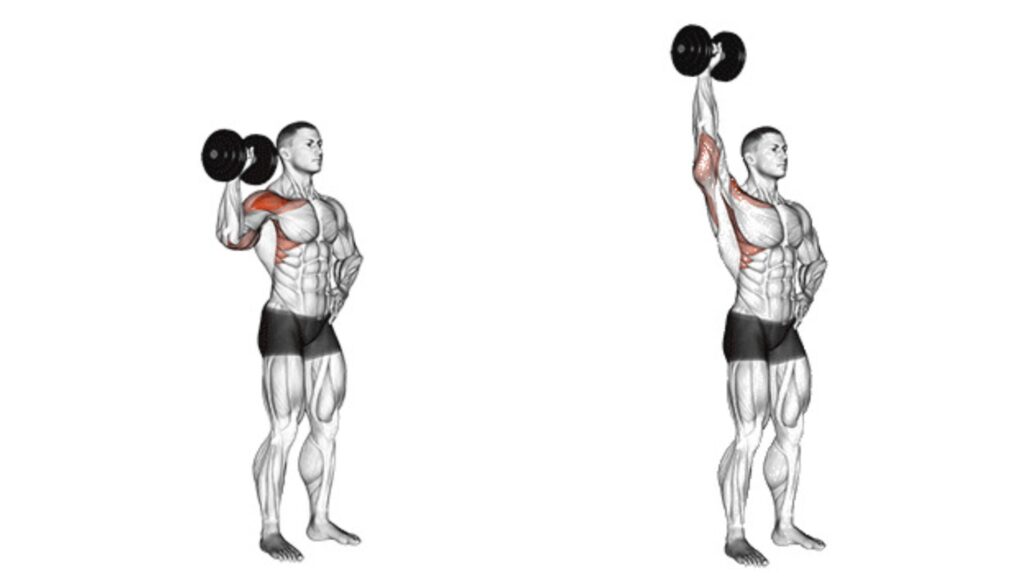
How To Do
- Stand with your feet shoulder-width apart. Hold a dumbbell in your one hand.
- Extend through your elbow to lift the dumbbell directly above you.
- Slowly lower the weight back to the starting position.
- Repeat on the left side after completing all reps on the right side.
Tips
- Keep a controlled motion and avoid jerky movements.
- Don’t allow your torso to sway to one side or the other as you press the weight overhead.
2. One-Arm Dumbbell Upright Row
Upright Row is one of the excellent single-arm shoulder exercises to build huge Trapezius muscles.
One arm dumbbell upright row is the unilateral variation on the dumbbell upright.

How To Do
- Stand with your feet shoulder-width apart.
- Hold a dumbbell in your left hand at your side.
- Slowly shrug your left shoulder up toward your ear.
- At the top, pause for a moment and contract the muscles.
- Slowly lower the weight back to the starting position.
- Repeat on the right side after completing all reps on the left side.
Tips
- Keep a controlled motion and avoid jerky movements.
- Keep your back straight and core tight.
Know More: Best Dumbbell Shoulder Exercises & Workouts For Mass
3. One Arm Dumbbell Bent Over Lateral Raise
The One-Arm dumbbell bent-over lateral raise is a unilateral variation of the bent-over lateral raise that targets one side of the posterior deltoid.
Unilateral exercises often demand greater focus and coordination. This allows you to connect better with your muscles, improving muscle activation and engagement.
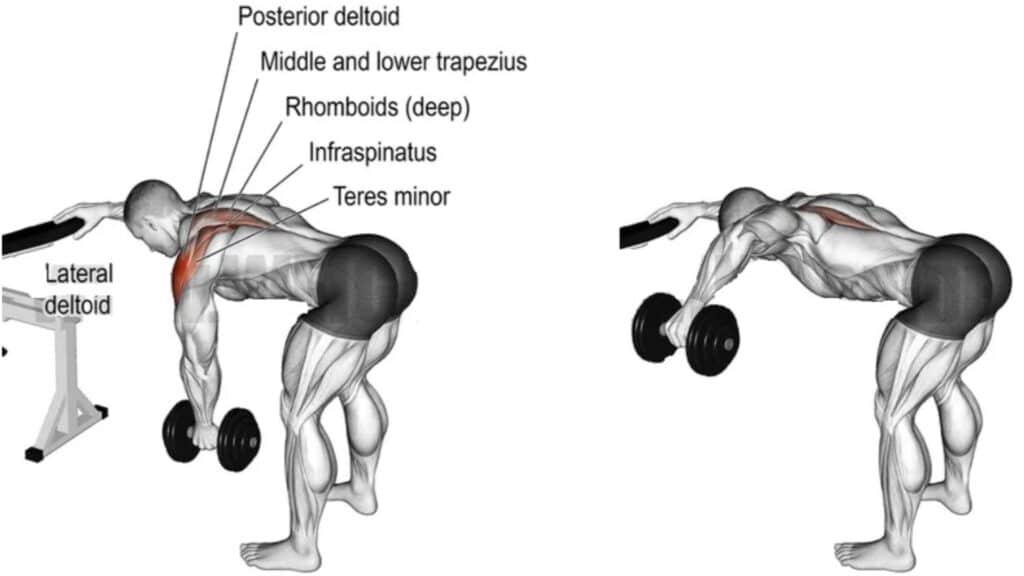
How To Do
- Hold a dumbbell in one hand. Bend your hips and knees until your torso is parallel to the floor.
- For stability, grasp something stable with your free hand.
- The dumbbells should be hanging straight down in front of you, with your palm facing inward (neutral grip)
- Keep your elbow slightly bent and raise the dumbbell to the side until it is leveled with your shoulders.
- Hold for a count of two and then slowly lower the dumbbells to the starting position.
- Repeat for the desired number of repetitions.
Tips
- Practice good form with a lightweight. Keep strict form to isolate the rear delts.
- Do not swing the dumbbells upward. Keep your back straight and your body still.
- Your arms should be parallel to your shoulders.
4. Lying Dumbbell Lateral Raise
Single-arm lying dumbbell lateral raise is another great exercise for your shoulder,
It increases strength and stability throughout the entire shoulder. This exercise more specifically targets the side deltoid.

How To Do
- Lie sideways on a flat bench, propping yourself up onto your elbow so it is perpendicular to the bench.
- Hold the dumbbells so that they rest sideways on your upper thigh
- Slowly lift the dumbbells up and out to the sides of your body, pulling through the rear delts and middle traps.
- Pause a moment at the top of the motion before slowly lowering the weights back down to the starting position.
- The “top” of the movement is when the shoulder joint is at a 90-degree angle to the body.
Tips
- Focus on moving in a slow and controlled fashion the entire time.
- Your working elbow should be slightly bent during the lift.
5. Side-Lying Rear Delt Fly
The side-lying rear delt fly is a shoulder exercise used to target the rear delts.
It is a great unilateral exercise used to target a smaller and often lagging muscle group.

How To Do
- Lie on the floor on your right side, and use a neutral grip to grasp the dumbbell with your left hand.
- Keeping your elbow fixed and your body still, exhale as you raise the dumbbell from the floor until it is almost vertical.
- Hold for a count of two.
- Inhale as you reverse the movement and lower the dumbbell towards the starting position, stopping before the dumbbell touches the floor.
- Repeat for the desired number of repetitions.
- Repeat the exercise on the opposite side with your right arm.
Tips
- Do not allow the dumbbell to touch the floor.
- Allow the arms to move freely, but don’t lock out the elbows.
To Stay Motivated: 150+ Gym Workout Motivational Quotes To Stay Fit
6. Single Dumbbell Front Raises
Single dumbbell front raises are exercises that specifically target the anterior deltoid muscle.
The exercise can be performed standing or seated, and it’s a great way to add definition and strength to the front of the shoulders.

How To Do
- Hold a dumbbell in one hand and let it hang at arm’s length at your side.
- Slowly raise the dumbbell out in front of your body, keeping your arm straight and your elbow slightly bent.
- Continue raising the dumbbell until it is level with your shoulder, then pause momentarily.
- Slowly lower the dumbbell back to the starting position and repeat for the desired number of reps.
- After the desired reps, switch sides and repeat the exercise.
Tips
- Keep your core engaged and your back straight throughout the exercise.
- Keep your movements slow and controlled.
7. Single Arm Cable Front Raise
The front raise is one of the most common shoulder exercises because it effectively builds the front delts.
By unilaterally performing the single-arm cable front raise exercise, you can focus on one side at a time.
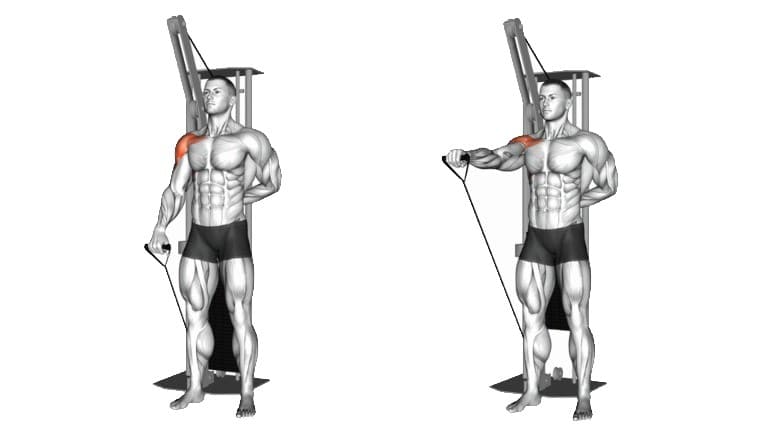
How To Do
- Attach a single grip handle to a low pulley cable machine.
- Stand facing away from the machine and grip the handle with your right hand using an overhand grip.
- Keeping your elbow very slightly flexed, exhale as you raise the stirrup (handle) forward and upward in a semicircular motion until your arm is above horizontal.
- Hold for a count of two.
- Inhale as you slowly reverse the motion and lower the stirrup to the starting position.
- Repeat the exercise with your opposite arm.
Tips
- This is an isolation exercise, so the focus should be on form and muscle contraction, not weight.
- Keep your body still. Only your arm should move.
Know More: Best cable shoulder Workout for 3D Shoulders
8. One Arm Cable Lateral Raise
The one-arm cable lateral raise is an isolated shoulder exercise that targets the deltoids while increasing stability in both the wrists and the core.
Cable lateral raise is a shoulder exercise that works the lateral head of the deltoid muscle, which is the rounded muscle at the very top of each shoulder.
You can use both arms while performing the exercise, but using just one is often recommended to make the workout more difficult and stimulate more gains.

How To Do
- Stand next to a cable pulley machine with your feet shoulder-width apart.
- The handle attachment adjusted to the lowest setting.
- Grab the handle and stand straight up with your arm fully extended and feet facing forward.
- Maintaining a slight bend in your working elbow, raise your arm up to shoulder height.
- Hold for a second, and then slowly lower the weight back to the starting position.
Tips
- Keep your torso still, your back straight, and your elbow slightly bent.
- Don’t just swing your arms. Keep controlled motion throughout the exercise.
9. Cable Twisting Overhead Press
Finally, try the cable-twisting overhead press if you want one more effective unilateral shoulder exercise.
The twisting cable overhead press is a very effective shoulder press variation which works the anterior (front) deltoids.
The twisting cable overhead press is brilliant for developing unilateral upper-body strength and improving your balance and the strength and stability of your core.

How To Do
- Attach a stirrup (handle) to a low or waist-high pulley. Grasp the stirrup with one hand.
- Spread your legs and squat a little, keeping your torso upright.
- Position the stirrup to the side of your body, with your elbow flexed and tucked into your side.
- Exhale as you straighten your legs, twist your body, and press the stirrup diagonally upward and away from the pulley.
- Hold for a count of two. Inhale as you reverse the motion and return your body and the stirrup to the starting position.
- Complete the desired number of reps with your right arm.
Tips
- You can place your free hand on your hip. You can squat as deep as you want to.
- Furthermore, you can only perform this exercise with one arm at a time.
10. Single Arm Arnold Press
The single-arm Arnold press is a compound exercise that works the deltoids, trapezius, and rotator cuff muscles. It is a variation of the traditional Arnold press performed with both arms.
The single-arm version allows you to focus on each shoulder individually, which can help prevent imbalances and improve overall strength.
How To Do
- Hold a dumbbell in each hand at shoulder height, palms facing your body.
- Slowly rotate one arm outward so your palm faces forward while pressing the dumbbell overhead.
- Fully extend your arm without locking the elbow, and pause briefly at the top.
- Reverse the motion, rotating the arm back to the starting position while lowering the dumbbell.
- Repeat on the other arm and alternate for the desired number of repetitions.
Tips
- Start with a light weight and gradually increase the weight as you get stronger.
- Avoid swinging the dumbbell up and down.
- Keep your back straight, shoulders down, and core engaged.
11. The Landmine Overhead Press
If you’re looking for a way to get more creative with your one-arm shoulder workout, why not try the Landmine Press?
Although it is not a popular exercise, it is one of the best single-arm shoulder exercises for progressing your anterior deltoid and upper chest.

How To Do
- Stand holding the weighted end of the barbell with both hands in front of your chest.
- Make sure the barbell is wedged securely in a landmine device or corner.
- Your feet should be level and shoulder-width apart.
- Press the weight up with both hands until your arms are extended, then bring it back down slowly.
Tips
- Hold a neutral spine throughout the movement to prevent injury.
12. One Arm kettlebell Swing
The one-arm kettlebell swing is a compound exercise that works the hips, glutes, hamstrings, quads, core, and shoulders.
It involves swinging a kettlebell with one arm, making it a challenging and effective full-body workout.
The one-arm kettlebell swing can help increase grip strength. This is important for other exercises, such as pull-ups and deadlifts.

How To Do
- Stand with your feet slightly wider than shoulder-width apart, toes pointed slightly outward.
- Hold a kettlebell in your right hand with an overhand grip.
- Hinge at the hips and slightly bend your knees to grip the kettlebell handle with one hand.
- Swing the kettlebell back between your legs, maintaining a neutral spine and a firm grip.
- Explosively thrust your hips forward while swinging the kettlebell up to shoulder height.
- Allow the kettlebell to swing back down between your legs, and immediately go into the next repetition.
13. Single Arm Dumbbell Snatch
The Single-arm dumbbell Snatch is an advanced, full-body exercise that targets the shoulders, back, and legs.
It’s a dynamic and powerful movement that requires great coordination, strength, and proper technique.
It is not recommended for beginners. Before attempting this exercise, it is essential to receive proper guidance and instruction from an experienced trainer.
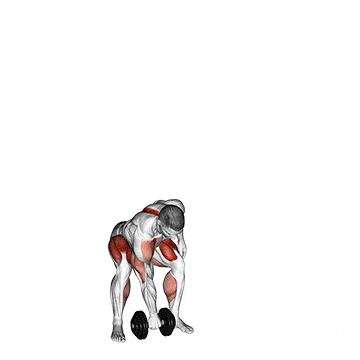
How To Do
- Start by standing with your feet shoulder-width apart and a dumbbell on the floor next to your feet.
- Reach down and grasp the dumbbell with one hand using an overhand grip.
- Start by extending through your hips and legs and pulling the dumbbell off the ground.
- Pull the dumbbell towards your shoulder when it reaches a hip height.
- Continue the movement by extending your arm overhead.
- Once your arm is fully extended overhead, pause briefly, then slowly lower the dumbbell back to the starting position.
- Repeat for the desired number of reps, then switch sides and repeat.
14. Leaning Dumbbell Lateral Raises
Leaning dumbbell lateral raises is an exercise that specifically targets the lateral deltoid muscle.
This lateral raise variation is a bit more advanced than the traditional standing version because it requires more balance and stability from the core.
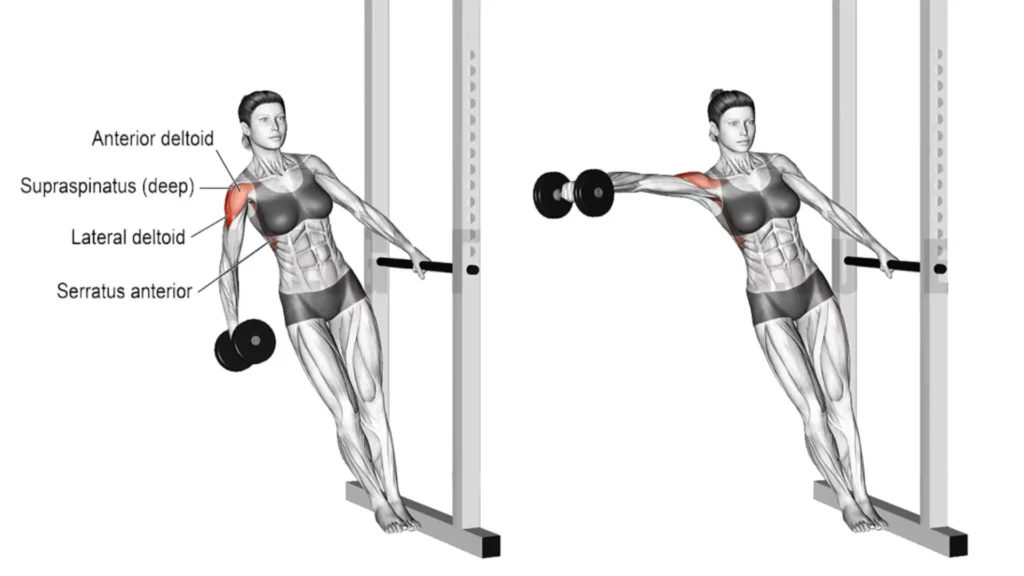
How To Do
- Start by standing with your feet shoulder-width apart and your core engaged.
- Hold a dumbbell in each hand and let them hang at arm’s length at your side.
- Lean your upper body forward at about a 45-degree angle.
- Slowly raise the dumbbells to the side, keeping your arms straight and elbows slightly bent.
- Continue raising the dumbbells until they are level with your shoulders, then pause momentarily.
- Slowly lower the dumbbells back to the starting position and repeat for the desired number of reps.
15. Dumbbell Rear Delt Row
The rear deltoid row exercise is simple and effective, and it is used to target your lats and rear deltoids.
This exercise is very similar to a basic one-arm dumbbell row for the lats, except with a couple of important modifications.

How To Do
- Start by placing your right foot on the floor with your left knee resting upon a bench.
- While keeping your back flat, pick up a dumbbell in your right hand.
- Begin by leading up with your elbow, bringing your arm up close to your chest, and squeezing with your back muscles.
- Once you reach the top of the exercise, stop and hold for a count, then return to the starting position. Switch sides and repeat.
Tips
- Keep a controlled motion and avoid jerky movements.
- Always use weights that you can comfortably handle.
Add Single Dumbbell Shoulder Exercises Into Your Workout Routine
They can be incorporated into your workout routine in various ways. Here are some options:
- As a standalone exercise: Do on 3–4 sets of 8–12 reps.
- As part of a shoulder workout: Do them along with other shoulder exercises.
- As part of a full-body workout: Do them with other compound exercises like squats, deadlifts, and bench presses.
Set, Reps, And Frequency
The number of reps you should do depends on your goals, whether they are to increase strength or build muscle mass and endurance.
- For muscle growth, it is best to do around 6–12 reps per set.
- For strength, around 3–8 reps per set are recommended.
- To build Muscle Endurance, do 15-20+ reps per set.
Here are some general guidelines for sets per week,
- Beginners: ~10 sets per week.
- Intermediate: ~15 sets per week.
- Advanced: ~20 sets per week.
One Arm Shoulder Workout Routine
1. Shoulder-Focused Workout Routine
| Exercise | Sets | Reps |
|---|---|---|
| Rear Delt Fly | 4 | 10-12 |
| Seated Shoulder Press | 3 | 8-10 |
| One Arm Lateral Raises | 3 | 12-15 |
| Front Raises | 3 | 10-12 |
| Upright Row | 3 | 12-15 |
2. Upper Body Strength And Definition Routine
| Exercise | Sets | Reps |
|---|---|---|
| Barbell Rows | 4 | 8-10 |
| Pull-Ups | 3 | 8-10 |
| Dumbbell Bench Press | 3 | 8-10 |
| One Arm Shoulder Press | 3 | 12-15 |
| Triceps Pushdowns | 3 | 10-12 |
3. Full-Body Strength And Stability Routine
| Exercise | Sets | Reps |
|---|---|---|
| Deadlifts | 3 | 6-8 |
| Squats | 4 | 8-10 |
| Bent-Over Rows | 3 | 8-10 |
| Single Arm Arnold Press | 3 | 12-15 |
| Incline Dumbbell Curl | 3 | 8-10 |
| Plank | 3 | 30 sec |
Advantages of Unilateral Shoulder Exercises
Single-arm shoulder exercises offer a range of advantages that make them a valuable addition to any fitness routine.
1. Improved Muscle Balance
Single-arm exercises address any imbalances between your left and right shoulders. Often, we have a dominant side that can overpower the other during bilateral exercises.
To work on each shoulder independently, you can identify and correct these imbalances, leading to more symmetrical and balanced shoulder development.
2. Enhanced Stability and Core Engagement
It challenges your core muscles as they work to stabilize your body and maintain balance. This not only strengthens your core but also translates to improved stability during various functional movements and sports activities.
3. Enhanced Proprioception and Mind-Muscle Connection
Unilateral exercises require greater focus and coordination, leading to better proprioception (awareness of your body’s position in space) and a stronger mind-muscle connection.
This heightened awareness can lead to more controlled and efficient movements during workouts.
4. Functional Benefits
Strong shoulders are crucial for everyday activities like lifting, carrying, and pushing objects.
Single-arm exercises mimic real-life movements more effectively, improving the functional strength of your shoulders and making everyday tasks easier and safer.
5. Increased Focus on Weak Points
If you have a particularly weak point in your shoulders, such as the rear delts or rotator cuff muscles, single-arm exercises allow you to focus on those areas.
This targeted focus can lead to significant improvements in specific muscle groups.
6. Variety and Versatility
Unilateral shoulder exercises offer a wide range of movements and can be performed with various equipment like dumbbells, resistance bands, and kettlebells. This versatility lets you keep your workouts fresh and interesting so you don’t get bored.
Conclusion
Single-arm shoulder exercises are a great way to build strong, balanced shoulders. They can also help prevent injuries, improve range of motion, and improve posture.
When doing one-arm shoulder exercises, it is important to use a challenging but not too heavyweight, focus on proper form, and switch sides between sets.
I hope this blog post has helped you to learn more about unilateral shoulder exercises.
If you want a challenge, try adding these exercises to your workout routine today.
Shoulder Workout With ONLY ONE DUMBBELL

Manish brings over 10 years of hands-on experience in weight lifting and fat loss to fitness coaching. He specializes in gym-based training and has a lot of knowledge about exercise, lifting technique, biomechanics, and more.
Through “Fit Life Regime,” he generously shares the insights he’s gained over a decade in the field. His goal is to equip others with the knowledge to start their own fitness journey.
